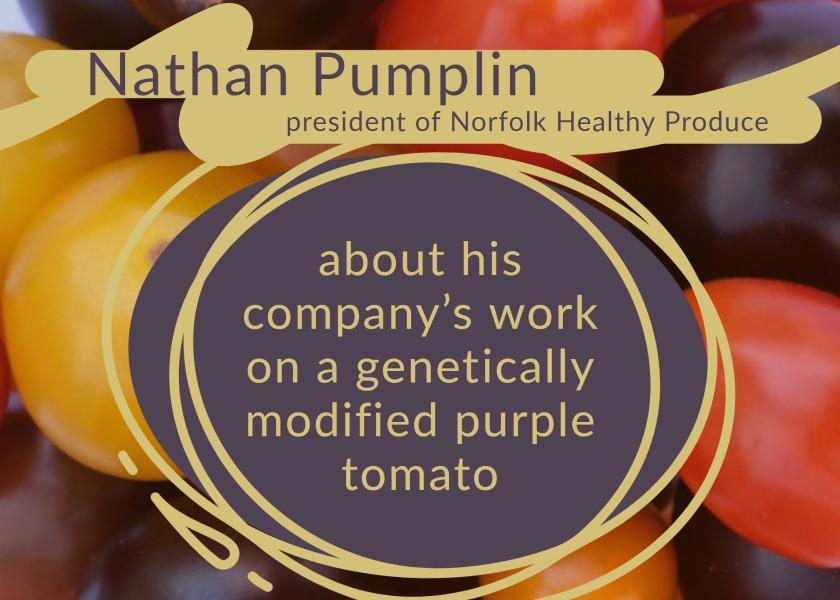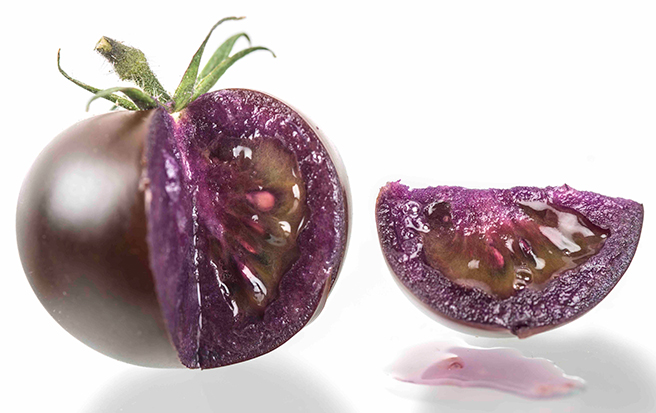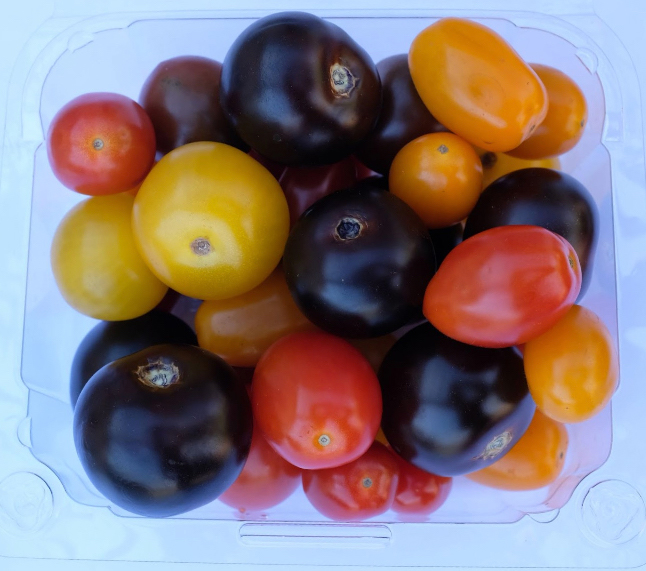Norfolk Healthy Produce bets on the power of the purple GMO tomato

The Packer’s Tom Karst visited in August with Nathan Pumplin, president of Norfolk Healthy Produce, about his company’s work on a genetically modified purple tomato.
The USDA recently released its response to the agency review of the purple tomato and determined that it may be safely grown and used in breeding in the United States. The agency said it did not identify any plausible pathways that the purple tomato had that increased plant pest risk compared to other cultivated tomatoes. Because of that, the agency said the plant is not subject to regulation.
Norfolk is now awaiting guidance from the U.S. Food and Drug Administration, and hopes to have limited commercial supply available in 2023, Pumplin said.
KARST: Nathan, give readers a little introduction on who you are and what you are doing.
PUMPLIN: I am the CEO and president of a new company called Norfolk Healthy Produce. We got

started as a spinoff called Norfolk Plant Sciences from the John Innes Centre and the Sainsbury Lab, two ... plant science research institutes in Norwich, United Kingdom. We have a special technology developed there by Professor Cathie Martin.
We set up a U.S.-based subsidiary at the end of last year to commercialize that technology in the U.S., and I’m leading that entity. We have some really fantastic industry veterans involved in the company.
And we are focused, for now, directly on tomatoes and launching a new product into that space, and building up a pipeline using our development expertise to meet some key unmet needs that consumers and supply chain players have.
My background is in a few things; first, a bit in advertising, then in biology. I have a [doctorate] in plant biology from Cornell. And, really, what I've done over the last 10 years is innovation in ag technology, food technology, using plant genetics, using science, really trying to solve some of the biggest problems we have.
And the two [problems] at the top of the list, for me, are sustainability — climate impacts of production systems — and the health and the quality of food that's going into people’s shopping carts, and ultimately, at the dinner table.
It's a complex supply chain, and I am amazed and grateful to our produce industry that (delivers) such high-quality produce. I think there are still opportunities to build on that, and that's where our company is focused.
“This decision is a big milestone, which brings us much closer to a commercial launch of purple tomatoes. We are optimistic that we can begin limited distribution of purple tomatoes in the U.S. in 2023," Pumplin said in a recent news release.
KARST: You are focusing on tomatoes to start with?
PUMPLIN: Yes, that's exactly right. The most mature technology that we have is the highly antioxidant purple tomato. And this is something that was developed by ... Martin ... She has been working for over 30 years in biology, understanding what makes different plants behave differently and, especially, what leads to different nutritional profiles and how can that be impacted.
She developed a technology that makes tomatoes very high in purple pigments called anthocyanins.
These are the antioxidants that make blueberries a superfood. [The purple tomato] is an extremely striking product. It looks unlike any tomato you've seen.
There are purple-skin tomatoes that are on the market, but our tomato is totally purple-fleshed inside.
It has much higher levels of these nutrients than any of the purple-skin tomatoes. You show it to someone in the industry, you show it to consumers, and they say, ‘Wow, that's beautiful. I've never seen a tomato like that.’
And, of course, it looks different and it looks beautiful. But the reason for that is these added nutrients. One of the other interesting benefits [of the purple tomato] is that it has an extended shelf life. These added antioxidants are not just good for people, they appear to slow the fruit-softening and rotting process, as well. It's nice for consumers and also helpful in the supply chain.
KARST: Is the purple tomato grown in the field or in the greenhouse?
PUMPLIN: The focus, for now, is protected culture production. And there are a few reasons that we're launching our first product that way. One, is that getting into the snacker category makes a lot of sense. It's a growing category. It's a favorite with consumers, it's positioned as a premium and you can get higher quality and consistency if you're growing in protected culture.
At the same time, this is a bioengineered produce product. We are far along the regulatory process right now. We are in discussion with the FDA, and we submitted to the USDA a year ago, under their newest rules.
It's a very interesting and exciting time because there are new regulations that have basically made this commercial launch possible.
Under the old regulations, it would have been $100 million to get through the development and regulatory process, and there was no way that we could recoup those costs. And luckily, for a number of reasons, there's a new path that allows a company like ours and a product like ours at least a chance to get out to market.
That's another reason why we're growing and breeding under containment right now. And the focus on protected culture sort of fits with those constraints, but also really fits with the go-to-market.
The other thing we're looking at is, because it's bioengineered, we can't grow it in Mexico and ship it to the U.S., for the time being. We can't grow it in Canada now, although there's a reasonable regulatory path for Canada right now. All of that drives our focus on domestic, local production. And that's a big need with consumers and with the supply chain to get more high-quality local produce.
This motivates us to work with local networks of growers/packers/shippers and guides our go-to-market focus for now.
As a small company looking to break into this market as a new entrant, we see a manageable barrier to market entry at farmers markets, farm stands, chefs and local restaurants, where we can really have intimate connections with the customers and get a lot of feedback. Who exactly are the customers interested in purple tomatoes? What's the marketing mix that resonates with them most? That's our focus now, and it is also on the path to demonstrating the potential of our product to larger retailers.

KARST: Is the tomato standard size?
PUMPLIN: We are targeting a 20-gram snacker tomato. We have a few prototypes that are ready right now. So, I should mention that I'm in Davis, Calif., and we have a greenhouse here where we're breeding and demonstrating our first product concepts.
KARST: Would that be the size of a grape tomato?
PUMPLIN: We're more focused on the cherry category right now. We have an active and growing variety development and trialing program, and we're sourcing germplasm and basically looking for the best hybrids that we can make.
We have a really strong path to get our minimum viable products out to market, and then, to fill our pipeline both with high-quality germplasm [and] other sources of innovations.
KARST: What types of bioengineering did you look at, and are the added anthocyanins from another plant?
PUMPLIN: Great question. It is from another plant; the genes that make the tomato purple are from the snapdragon, and this came from Cathie’s initial work.
Tomatoes can make purple pigments, they make them normally in the stems. If you picture a seedling of tomato that you transplant in your garden, oftentimes, the stems are a bit purple and the leaves can turn purple, as well.
They can make these nutrients; they just typically don't make them in the fruits. But when you go to the supermarket and you see these purple-skin tomatoes, that's a completely natural, traditionally bred process. It's the same nutrients that we have in our tomatoes; the bioengineering trick is to activate them, not just in the skins, but in the entire fruit. And that's why we get (the antioxidants) at much higher levels. The way they're activated is this gene from snapdragon, which turns on the same pathway in petals of flowers to attract pollinators.
So, we haven't put in something new. We put in a plant-based 'on' switch to a pathway that is already there.
KARST: And how long ago did work start on the purple tomato? I know that these genetically modified varieties can be a long time in development.

PUMPLIN: This is something that I'm really proud to say, because, having worked in the biotech research and development space, those timelines are very long.
Cathie started work 15 years ago, and the thing that's great about Cathie is, she didn't just make a purple tomato; she has made lots of different, specialty-fortified tomatoes. She has one that has resveratrol, the compound that's in red wine that's very healthy. She has a vitamin D tomato; she has a few other really great tomatoes that are high in different extra nutrients. This [purple tomato] one was first published in a peer-reviewed paper in 2008. And over five subsequent publications have shown different unique attributes of this type of engineered tomatoes — the added features, advantages and benefits that come from this. The other thing that's really great is the technology is proven on a scientific level. For me, having worked in this area, it's really important to know how stable is it.
Sure, you showed it in a lab, but does it actually work? And what types of tomatoes does it work in? So, for 10 years, Cathie and her lab have been breeding this in different varieties and taking it through many generations; over 15 generations of tomatoes.
It's very stable. It stays purple. We know that you can put it into a big slicer tomato, you can put it into a processing tomato and you can put it in a cherry tomato, and you get a range of different levels of purple, just as different tomatoes are different shades of red or yellow. But what you get is very consistent purple and very consistent, high anthocyanins.
KARST: Interesting. How does the purple tomato taste?
PUMPLIN: It tastes like a really good tomato. It’s important to remember that a tomato has 30,000 to 35,000 genes, and we've added two, but the taste and the flavor of the tomatoes are impacted by the entire genome, everything that's in the tomato, all of that essential plant breeding, and of course, the production environment. So, we are in the process of selecting the diversity that we have to pick the best, most flavorful, most nutritious tomato lines.
These taste really good. And what I'm interested to find out, once we have the market tests up and running, is how people judge the flavor. Some people report not liking the flavor of purple-skinned tomatoes currently on the market, and they wonder whether our purple tomato can really taste good.
I think the main reason for the disappointing taste is that the purple tomatoes on the market are bred from these wild species of tomatoes; they have a lot of other genes because of that breeding, which confers other flavors and attributes that are not great for commercial tomatoes. And that's really an advantage of using bioengineering [is], we can take great tomatoes and simply bioengineer the added purple into that background. But we don't change all the other attributes.







